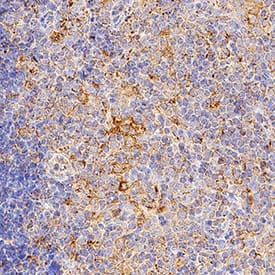Mouse IL-6 Biotinylated Antibody
R&D Systems, part of Bio-Techne | Catalog # BAF406


Key Product Details
Species Reactivity
Validated:
Mouse
Cited:
Human, Mouse
Applications
Validated:
ELISA Detection (Matched Antibody Pair), Immunohistochemistry, Western Blot
Cited:
ELISA Detection, ELISA Development, ELISA Development (Detection), Immunohistochemistry-Paraffin, Luminex Development, Western Blot
Label
Biotin
Antibody Source
Polyclonal Goat IgG
Product Specifications
Immunogen
E. coli-derived recombinant mouse IL-6
Phe25-Leu211
Accession # P08505
Phe25-Leu211
Accession # P08505
Specificity
Detects mouse IL-6 in ELISAs and Western blots. In sandwich immunoassays, less than 0.04% cross‑reactivity with recombinant human IL-6, recombinant rat IL-6, and recombinant porcine IL-6 is observed.
Clonality
Polyclonal
Host
Goat
Isotype
IgG
Scientific Data Images for Mouse IL-6 Biotinylated Antibody
IL‑6 in Mouse Thymus.
IL-6 was detected in perfusion fixed frozen sections of mouse thymus using Goat Anti-Mouse IL-6 Biotinylated Antigen Affinity-purified Polyclonal Antibody (Catalog # BAF406) at 1 µg/mL overnight at 4 °C. Tissue was stained using the Anti-Mouse HRP-AEC Cell & Tissue Staining Kit (brown; Catalog # CTS003) and counterstained with hematoxylin (blue). Specific staining was localized to cell surfaces in lymphocytes. View our protocol for Chromogenic IHC Staining of Frozen Tissue Sections.Applications for Mouse IL-6 Biotinylated Antibody
Application
Recommended Usage
Immunohistochemistry
1-15 µg/mL
Sample: Perfusion fixed frozen sections of mouse thymus
Sample: Perfusion fixed frozen sections of mouse thymus
Western Blot
0.1 µg/mL
Sample: Recombinant Mouse IL-6 (Catalog # 406-ML)
Sample: Recombinant Mouse IL-6 (Catalog # 406-ML)
Mouse IL-6 Sandwich Immunoassay
Please Note: Optimal dilutions of this antibody should be experimentally determined.
Formulation, Preparation, and Storage
Purification
Antigen Affinity-purified
Reconstitution
Reconstitute at 0.2 mg/mL in sterile PBS.
Formulation
Lyophilized from a 0.2 μm filtered solution in PBS with BSA as a carrier protein.
Shipping
The product is shipped at ambient temperature. Upon receipt, store it immediately at the temperature recommended below.
Stability & Storage
Use a manual defrost freezer and avoid repeated freeze-thaw cycles.
- 12 months from date of receipt, -20 to -70 °C as supplied.
- 1 month, 2 to 8 °C under sterile conditions after reconstitution.
- 6 months, -20 to -70 °C under sterile conditions after reconstitution.
Background: IL-6
Long Name
Interleukin 6
Alternate Names
BSF-2, BSF2, IFNB2, IL6, MGI-2A
Entrez Gene IDs
Gene Symbol
IL6
UniProt
Additional IL-6 Products
Product Documents for Mouse IL-6 Biotinylated Antibody
Product Specific Notices for Mouse IL-6 Biotinylated Antibody
For research use only
